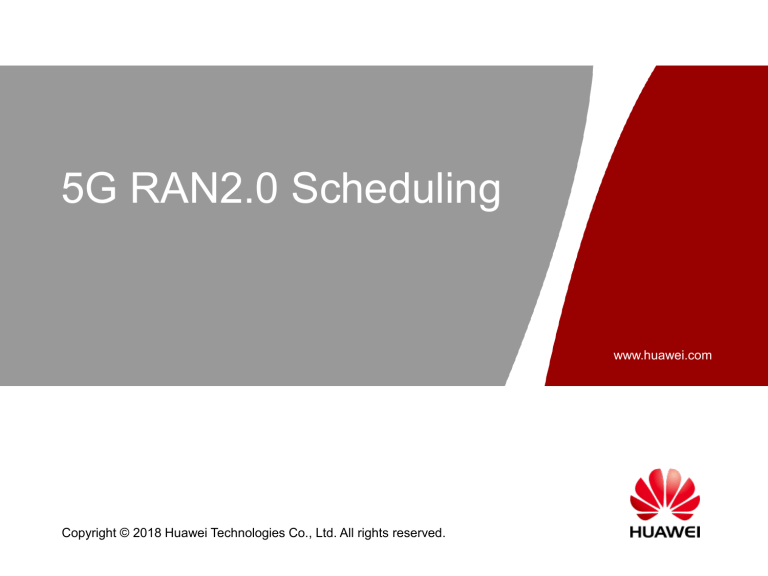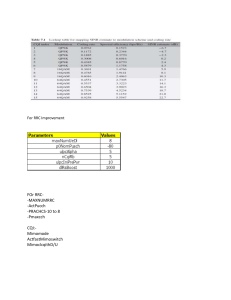
5G RAN2.0 Scheduling www.huawei.com Copyright © 2018 Huawei Technologies Co., Ltd. All rights reserved. Preface To improve spectral efficiency, the New Radio (NR) system uses shared channels for transmission and time-frequency resources are dynamically allocated among UEs. The resource allocation mode (such as modulation scheme, and allocation priority) directly affects user perception and network performance. Copyright © 2018 Huawei Technologies Co., Ltd. All rights reserved. Page 2 Objectives Upon completion of this course, you will be able to: Have a basic knowledge of the Scheduling feature. List the scheduling algorithms of Huawei gNodeB. Describe basic and enhanced uplink/downlink scheduling. Describe scheduling methods for typical services. Copyright © 2018 Huawei Technologies Co., Ltd. All rights reserved. Page 3 Contents 1. Technical Principles 2. Downlink Scheduling 3. Uplink Scheduling Copyright © 2018 Huawei Technologies Co., Ltd. All rights reserved. Page 4 Introduction • Scheduling enables the gNodeB to allocate PDSCH or PUSCH resources (time domain, frequency domain, or spatial domain resources) to UEs for transmitting system information or user data. The resource allocation must comply with the frame structure configuration and use a scheduling basic unit. • Key factors Frame structure configuration Upper layer Basic scheduling unit Scheduler (MAC entity) Execution Downlink scheduler • The figure on the right illustrates downlink scheduling. Cell Copyright © 2018 Huawei Technologies Co., Ltd. All rights reserved. Page 5 MAC layer Frame Structure Configuration Example: TDD, 30-kHz subcarrier, uplink/downlink subframe assignment = 1:4 Three slot formats: downlink-specific slot, uplink-specific slot, and slot with flexible configuration One radio frame (10 ms), containing 20 slots (0.5 ms per slot) D D D S U D D D S U D D Copyright © 2018 Huawei Technologies Co., Ltd. All rights reserved. D S U Page 6 D D D S U Basic Scheduling Unit: PRB Slot D S U D D D S … 1 slot D GAP U D U D D GAP U 1 slot, 14 OFDM symbols PRB PRB … … PRB PRB Band (GHz) Mode Subcarrier Bandwidth (KHz) (MHz) RB Count 1.8 FDD 15 20 106 3.5 TDD 30 100 273 28/39 TDD 120 100 66 Copyright © 2018 Huawei Technologies Co., Ltd. All rights reserved. Page 7 12 subcarriers PRB PRB Implementation Scheduling is implemented by schedulers (MAC entities), which are located at the UE and the gNodeB separately in the NR system. RRC PDCP PDCP RLC RLC Layer 3 Layer 2 Logical channel MAC MAC PHY PHY UE gNB Transport channel Physical channel Copyright © 2018 Huawei Technologies Co., Ltd. All rights reserved. Page 8 Layer 1 MAC Entity Upper layer PCCH BCCH CCCH DCCH DTCH MAC control Logical channel priority (uplink) Multiplexing/Demultiplexing Random access control HARQ PCH BCH DL-SCH UL-SCH RACH Lower layer Copyright © 2018 Huawei Technologies Co., Ltd. All rights reserved. Page 9 Control Execution CQI/RI/PMI PDCCH (DCI) PDSCH&PUSCH Basic process: The UE measures user-level CSI-RI SINR and reports channel quality information such as CQI/RI/PMI to the gNodeB. Based on the reported channel quality and UE capability, the gNodeB selects a proper MCS and transmits data on the PDSCH/PUSCH. The UE obtains the uplink/downlink resource allocation information from the DCI carried over the PDCCH. Copyright © 2018 Huawei Technologies Co., Ltd. All rights reserved. Page 10 CQI CQI indicates the channel quality. The CQI reported by the UE to the gNodeB is obtained after quantification on the SINR obtained from pilot measurement. In 5G RAN1.0, the reported CQI is measured on full bandwidth and used for: MCS and TBS selection Copyright © 2018 Huawei Technologies Co., Ltd. All rights reserved. Page 11 PDCCH&PDSCH Example: 30-kHz subcarrier, D slot Example: 30-kHz subcarrier, S slot One slot = 0.5 ms One slot = 0.5 ms PDCCH PDSCH PDCCH Copyright © 2018 Huawei Technologies Co., Ltd. All rights reserved. PDSCH Page 12 GP SRS PDSCH Resource Allocation Power Sequential allocation UE1 UE2 20 MHz RBG size 4 as an example UE3 … Frequency Start RB System bandwidth Total RB Count RBG Size 1-36 2 37-72 4 73-144 8 145-273 16 Copyright © 2018 Huawei Technologies Co., Ltd. All rights reserved. Page 13 Contents 1. Technical Principles 2. Downlink Scheduling 3. Uplink Scheduling Copyright © 2018 Huawei Technologies Co., Ltd. All rights reserved. Page 14 Terms Modulation and coding scheme (MCS) Represents a particular combination of a modulation scheme and a channel code rate. Layer 2 determines the MCS for each UE to be scheduled. Hybrid automatic repeat request (HARQ) feedback Indicates whether data has been correctly transmitted or retransmitted. It can be acknowledgment (ACK) or negative acknowledgment (NACK). Carrier bandwidth part (BWP) Indicates a combination of contiguous RBs. The BWP of UEs is generally smaller than the gNodeB system bandwidth. UEs can be scheduled over the same BWP at the same time. Copyright © 2018 Huawei Technologies Co., Ltd. All rights reserved. Page 15 Processing by the Scheduler Processing physicallayer measurement information Scheduler Scheduling in each TTI Data -Downlink data buffer status -HARQ feedback status Processing scheduling information Dynamic scheduling MCS & Rank for scheduled UEs Priority calculation PRB and TBS allocation for scheduled UEs MCS selection Rank for scheduled UEs Resource allocation Inputs Copyright © 2018 Huawei Technologies Co., Ltd. All rights reserved. Outputs Page 16 Downlink Scheduling – Inputs HARQ feedback • Whether retransmission or initial transmission is required Downlink buffer status • Used for calculating the required resources else gNodeB model and UE capability,etc Copyright © 2018 Huawei Technologies Co., Ltd. All rights reserved. Page 17 Downlink Scheduling – Process Data and scheduling type UE and priority MCS selection PDSCH allocation DMRS allocation end Copyright © 2018 Huawei Technologies Co., Ltd. All rights reserved. Page 18 Control-Plane Scheduling Control-plane information includes: Common control information: remaining minimum system information (RMSI) and Paging and random access response (RAR) Dedicated control information: SRB0, SRB1, SRB2,and SRB3 User-plane information Copyright © 2018 Huawei Technologies Co., Ltd. All rights reserved. Page 19 Downlink HARQ Retransmission Scheduling Process Start No Are there UEs qualified for HARQ retransmissions? Yes The gNodeB selects a UE requiring an HARQ retransmission No No Is the number of consecutive failed HARQ retransmissions smaller than the upper limit? Yes Are there remaining downlink resources? Yes End The gNodeB allocates resources for the HARQ retransmission. Copyright © 2018 Huawei Technologies Co., Ltd. All rights reserved. Page 20 Priorities of UEs with Initial Transmissions Huawei gNodeB supports the proportion fairness (EPF) algorithm. Copyright © 2018 Huawei Technologies Co., Ltd. All rights reserved. Page 21 PDSCH Resource Allocation Type0 Several continuous RBs form an RB group (RBG), and RBs to be used are indicated in the unit of RBG. The number of RBs that an RB group has is determined by the downlink bandwidth. Number of Downlink PRBs RBG Size 1 to 36 2 37 to 72 4 73 to 144 8 145 to 273 16 Copyright © 2018 Huawei Technologies Co., Ltd. All rights reserved. Page 22 PDSCH Resource Allocation Type0 Take 34 downlink RBs for example. The RBG size is 2 and the 34 RBs can be divided into 17 RBGs (34/2). If 18 RBs are scheduled for a UE, which are mapped to RBGs 2, 3, 4, 5, 8, 10, 11, 13, and 17. The bitmap of this example is as follows: 34 RBs RBG 1 2 3 4 5 6 7 8 9 10 11 12 13 14 15 16 17 Bitmap (0/1) 0 1 1 1 1 0 0 1 0 1 Copyright © 2018 Huawei Technologies Co., Ltd. All rights reserved. 1 0 Page 23 1 0 0 0 1 Questions What is the basic process of downlink scheduling? What advantages and disadvantages does the PF scheduling algorithm present? Copyright © 2018 Huawei Technologies Co., Ltd. All rights reserved. Page 24 Downlink Scheduling-Related Parameters PDSCH IBLER target value The PDSCH IBLER target value can be configured to ensure network performance for cell-center, near-of-center, and cell-edge UEs in different commercial network scenarios. Parameters PDCCH IBLER target value AMC step adjustment switch The PDCCH IBLER target value can be configured to ensure network performance for cell-center, near-of-center, and celledge UEs in different commercial network scenarios. The AMC adjustment step can be adjusted so that fast IBLER convergence can be allowed to improve throughput. Copyright © 2018 Huawei Technologies Co., Ltd. All rights reserved. Page 25 Downlink Interference Randomizationbased Scheduling The resource allocation start location of each cell is different from its neighbor clls to get a smaller interference. Copyright © 2018 Huawei Technologies Co., Ltd. All rights reserved. Page 26 Contents 1. Technical Principles 2. Downlink Scheduling 3. Uplink Scheduling Copyright © 2018 Huawei Technologies Co., Ltd. All rights reserved. Page 27 Terms PHR BSR A power headroom report (PHR) indicates the difference between the maximum allowed TX power and the used TX power in the uplink. UEs send PHRs to the gNodeB periodically or in event-triggered mode. The buffer status report (BSR) indicates the amount of to-besent data in the uplink buffer of a UE. SR The scheduling request carries 1-bit information that a UE sends to the gNodeB over the uplink channel to request uplink resources for data transmission. Copyright © 2018 Huawei Technologies Co., Ltd. All rights reserved. Page 28 Uplink Scheduling Resource – PUSCH Front-loaded RS Short PUCCH Long PUCCH Additional RS PRACH 1 RB/12 subcarriers 273 RBs (30 kHz@100 MHz) PUSCH 1 subframe/14 symbols Uplink subframe Copyright © 2018 Huawei Technologies Co., Ltd. All rights reserved. Page 29 Uplink Scheduling Process UE gNodeB Scheduling Request (PUCCH) BSR & PHR (PUSCH) Uplink scheduling command (PDCCH) Schedule based on the logical channel group Schedule based on each logical channel Uplink data (PUSCH) Copyright © 2018 Huawei Technologies Co., Ltd. All rights reserved. Page 30 Uplink Scheduler Copyright © 2018 Huawei Technologies Co., Ltd. All rights reserved. Page 31 Uplink Scheduling – Inputs HARQACKs/NACKs • Whether retransmission or initial transmission is required SINR • Uplink channel conditions obtained from the sounding reference signal (SRS) and demodulation reference signal (DMRS) measurement PHR • Power status of a UE BSR • Amount of to-be-sent data in the uplink buffer of a UE SR • 1-bit information that a UE sends to the gNodeB over the uplink channel to request uplink resources for data transmission Copyright © 2018 Huawei Technologies Co., Ltd. All rights reserved. Page 32 Uplink Scheduling – Priority Copyright © 2018 Huawei Technologies Co., Ltd. All rights reserved. Page 33 Uplink HARQ Retransmission Scheduling Uplink scheduling for retransmissions uses asynchronous adaptive retransmission. In HARQ retransmissions, the MCS can be adaptively selected and differ from the MCS for initial transmissions. A HARQ retransmission and an initial transmission use the same TBS. If the gNodeB replies with an ACK to a packet sent by a UE on the PUSCH, the UE does not transmit the packet again. If the reply is NACK, retransmission scheduling is triggered for this packet. In asynchronous adaptive retransmission, a DCI must be delivered to instruct the UE to perform retransmissions. After the number of uplink HARQ transmissions reaches the maximum number of 5, uplink HARQ retransmission stops. Copyright © 2018 Huawei Technologies Co., Ltd. All rights reserved. Page 34 Control-Plane Scheduling Control-plane data includes uplink SRBs and the DRBs that carry IMS signaling. The gNodeB often uses a small MCS index and fixed RB resources for control information to ensure correct reception. Copyright © 2018 Huawei Technologies Co., Ltd. All rights reserved. Page 35 Uplink Scheduling for Initial Transmissions Initial transmissions in uplink scheduling include to-be-scheduled UE selection, scheduling resource acquisition, MCS selection, and RB allocation (the number and positions of allocated RBs). To-be-scheduled UE selection Scheduling resource acquisition RB selection MCS selection Copyright © 2018 Huawei Technologies Co., Ltd. All rights reserved. Page 36 To-Be-Scheduled UE Selection The uplink scheduler selects the target UEs with initial transmissions based on the scheduling priorities. EPF is supported in the uplink: 𝑒𝑓𝑓 𝐴𝑙𝑝ℎ𝑎 𝑝𝑟𝑖𝑜𝑟𝑖𝑡𝑦 = 𝑟 • eff: uplink channel quality obtained from the SINR of gNodeBmeasured SRS • Alpha: uplink capacity factor that has the same function as the downlink capacity factor • r: historical rate of a UE Copyright © 2018 Huawei Technologies Co., Ltd. All rights reserved. Page 37 RB Allocation The uplink scheduler determines the RB resources required by a UE in a TTI based on the buffer status (BSR), power headroom status, and hardware limitations. UE power headroom gNodeB hardware limitations UE buffer status Number of RBs required by the UE Copyright © 2018 Huawei Technologies Co., Ltd. All rights reserved. Page 38 PUSCH Waveforms 5G PUSCHs support two waveforms: CP-OFDM and DFT-SOFDM. CP-OFDM is characterized by flexible resource allocation and high frequency diversity gain thanks to the use of discontinuous frequency-domain resources. However, it causes high peak-toaverage power ratio (PAPR). DFT-S-OFDM ensures low PAPR and high transmit power, with the PAPR approximately close to that of a single carrier. However, it requires continuous frequency-domain resources. Huawei products support adaptive switching between the two waveforms. Copyright © 2018 Huawei Technologies Co., Ltd. All rights reserved. Page 39 PUSCH RB Allocation Uplink scheduling uses frequency selective scheduling or frequency diversity scheduling to allocate uplink resources. Frequency selective scheduling: The uplink scheduler sets a sliding window for each UE based on the number of RBs required by the UE. During frequency selective scheduling, the uplink scheduler slides the window in sequence in the frequency domain and selects the resource combination with the maximum expected gain in the window to allocate resources to the UE. The SINR in the window is used to calculate the expected gain of the sliding window during uplink frequency selective scheduling. Frequency diversity scheduling: The uplink scheduler allocates RBs to each UE in sequence based on the number of RBs required by the UE in uplink frequency diversity scheduling. Frequency selective scheduling yields gains by leveraging differences in channel quality or interference. However, it may result in frequency band fragments and inefficient use of RBs. In addition, frequency selective scheduling is complicated and results in high processing overheads. The gNodeB in the NR system adaptively enables or disables uplink frequency selective scheduling based on the number of synchronized UEs in a cell. When uplink frequency selective scheduling is disabled, frequency diversity scheduling is performed. Copyright © 2018 Huawei Technologies Co., Ltd. All rights reserved. Page 40 PUSCH Discontinuous RB Allocation If the allocated RB resources in an uplink slot cause frequency band fragments, the gNodeB allocates inconsecutive RB resources for to-be-scheduled UEs. When selecting the uplink RB location of each UE, the gNodeB searches for the RB segment that meets the requirements and can deliver the highest spectral efficiency. Frequency band UE 2 UE 2 RBs required for UE 3 ...UE 3 Consecutive resource allocation UE 1 UE 3 Frequency band ...UE 3 UE 2 Inconsecutive resource allocation UE 1 Inconsecutive resource allocation: Inconsecutive RB segments are allocated to the to-be-scheduled UEs. Gain: Increase the cell capacity by 5%. Copyright © 2018 Huawei Technologies Co., Ltd. All rights reserved. Page 41 Uplink Interference Randomizationbased Scheduling Baseline (without this function enabled) RB resources are allocated for cells from the low frequency band, resulting in a high RB collision rate and strong co-channel interference. Interference Randomization-based Scheduling The RB resources allocated to each cell are staggered, the RB collision rate is low, and the intra-frequency interference is small. Resource search direction Resource search direction Scheduling RBs Cell 1 Cell 1 Start location Cell 0 Cell 2 Mode 6: PCI%6= 0 1 Mode 3: PCI%3= 0 Cell 0 2 Cell 2 3 4 1 Mode 2: PCI%2= Mode 3 RbUtil-based mode 3to-mode 6 switching 5 2 0 Low frequency RbUtil-based mode 6to-mode 3 switching Mode 6 Start location 1 High frequency Resource search direction RbUtil-based mode 3RbUtil-based mode 2to-mode 2 switching to-baseline switching Mode 2 RbUtil-based mode 2to-mode 3 switching Copyright © 2018 Huawei Technologies Co., Ltd. All rights reserved. Baseline RbUtil-based baselineto-mode 2 switching Page 42 MCS Selection for Uplink Scheduling Involve three steps: SINR adjustment, initial MCS selection, and MCS adjustment, as illustrated in the following figure: Uplink IBLER adaptation During MCS selection, the uplink scheduler can adaptively select the IBLER target based on the average value and variance of SINRs. This improves UE throughput. Initial uplink SINR adjustment The initial uplink SINR adjustment value can be configured using a parameter. The default value is -4 dB. Copyright © 2018 Huawei Technologies Co., Ltd. All rights reserved. Page 43 Uplink Scheduling Enhancement: Preallocation After the gNodeB schedules resources for UEs with data transmission, it initiates uplink scheduling for UEs if uplink resources are sufficient. This is called preallocation. Benefits: Shorten the UE scheduling delay. A UE is in a preallocation queue when the following conditions are met: The UE is not scheduled within the current TTI. The UE meets the minimum interval between preallocations. The UE has a preallocation weight greater than 0. Copyright © 2018 Huawei Technologies Co., Ltd. All rights reserved. Page 44 Uplink Scheduling-Related Parameters Adaptive Uplink Waveform If this switch is turned on, the gNodeB selects transmitting signal waveform for UEs and instructs UEs to change waveforms according to the radio environment. If this switch is turned off, the gNodeB instructs UEs to use the CP-OFDM waveform. Parameters Uplink IBLER Adaptation Switch Initial Uplink SINR Adjustment If this switch is turned on, the IBLER target value is adaptively selected based on UE's uplink SINR mean value and variance. If this switch is turned off, the uplink IBLER target value is fixed at 10%. This parameter specifies the initial value of uplink SINR adjustment. It is -4 dB by default. Copyright © 2018 Huawei Technologies Co., Ltd. All rights reserved. Page 45 Questions What is the basic process of uplink scheduling? What factors can have an impact on uplink scheduling? How do we determine the number of RBs during uplink scheduling? Copyright © 2018 Huawei Technologies Co., Ltd. All rights reserved. Page 46 Thank you www.huawei.com


